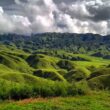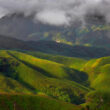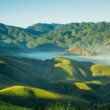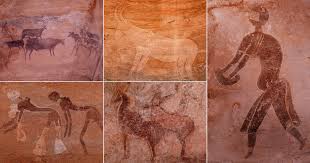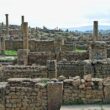Nestled in the far southeastern corner of Algeria, Tassili n’Ajjer is a place where history, art, and nature collide in spectacular fashion. This vast plateau of sandstone formations and canyons, stretching over 72,000 square kilometers, is not only an adventurer’s paradise but also one of the most archaeologically significant regions in the world.
Home to over 15,000 ancient rock paintings and engravings, Tassili n’Ajjer offers a glimpse into a time when the Sahara was green and teeming with life. Designated as a UNESCO World Heritage Site in 1982, the region attracts geologists, historians, trekkers, and culture enthusiasts alike.
Where is Tassili n’Ajjer?
Tassili n’Ajjer is located in the Southeast of Algeria, bordering Libya, Niger, and Mali. The nearest major city is Djanet, which serves as the gateway to this Saharan treasure. The park sits atop a high plateau in the central Sahara Desert and is part of the Ahaggar mountain range.
Why Visit Tassili n’Ajjer?
Tassili n’Ajjer is more than a desert; it’s a journey through time. This region was once lush and fertile, inhabited by humans, wildlife, and complex cultures. Here’s what makes it special:
1. Prehistoric Rock Art
Some of the world’s oldest and most diverse petroglyphs and paintings reside in Tassili. These artworks, dating back over 12,000 years, depict animals like elephants, giraffes, and hippos — animals that no longer inhabit the region — offering proof of the Sahara’s greener past.
2. Geological Marvels
The landscape is dominated by sandstone forests, natural arches, deep canyons, and surreal rock formations that resemble lunar or Martian terrain. It’s often compared to the landscapes of Utah or Arizona, but on a much grander, untouched scale.
3. Unique Flora and Fauna
Tassili is also home to the endangered Saharan cypress and olive trees, remnants of a time when the Sahara was hospitable. Several endemic species survive here, isolated in pockets of moisture among the rocks.
4. Indigenous Tuareg Culture
The Tuareg people, often called the “Blue People of the Sahara,” inhabit the region and serve as expert guides. Their nomadic lifestyle, deep knowledge of the terrain, and hospitality add a rich cultural layer to any visit.
Top Experiences in Tassili n’Ajjer
1. Rock Art Tours
Join a guided tour to explore rock shelters like Sefar, Jabbaren, and Tamrit, where thousands of petroglyphs tell stories of ancient societies.
2. Multi-day Trekking
Trekking through the plateau offers a mix of challenging hikes and breathtaking scenery, from towering cliffs to hidden oases.
3. Visit the Oasis Town of Djanet
Djanet is the starting point for most Tassili adventures. Explore its palm groves, traditional markets, and old ksour (fortified villages).
4. Stargazing in the Sahara
With virtually no light pollution, the clear desert skies offer unmatched stargazing opportunities — perfect for night photography or simply admiring the cosmos.
5. Learn from the Tuareg
Many tours include cultural immersion, where visitors can learn about Tuareg music, poetry, desert survival skills, and camel handling.
Best Time to Visit Tassili n’Ajjer
The ideal time to explore Tassili is between October and March, when daytime temperatures are pleasant (15–25°C) and the risk of sandstorms is lower. Summers can be dangerously hot, often exceeding 45°C (113°F).
Getting to Tassili n’Ajjer
- By Air: Fly to Djanet In Amenas Airport via Algiers.
- By Land: Overland travel is possible but requires permits and experienced guides due to remote conditions.
- Tour Operators: Several Algerian and international agencies organize multi-day expeditions with logistics, guides, food, and camping gear included.
Travel Tips for Tassili n’Ajjer
- Travel with a registered guide or tour company.
- Pack light, but bring essentials: sunscreen, a hat, comfortable hiking boots, and layered clothing.
- Expect camping: There are few formal accommodations in the park.
- Hydrate regularly and carry purification tablets or filters.
- Bring cash: There are limited ATM or card services in Djanet.
- Respect the heritage: Do not touch or deface the rock art.
UNESCO Recognition
In 1982, Tassili n’Ajjer was inscribed as a UNESCO World Heritage Site for its exceptional value as:
- A prehistoric art gallery,
- A unique geological formation, and
- A biodiversity refuge in an otherwise arid landscape.
UNESCO highlighted it as a critical record of early human civilization, reflecting societal shifts in response to climate change and desertification.
10 Frequently Asked Questions (FAQs)
1. What does “Tassili n’Ajjer” mean?
It means “Plateau of the Rivers of Ajjer” in the Tamahaq Tuareg language, referencing the now-dry riverbeds that once flowed through the region.
2. How old is the rock art in Tassili n’Ajjer?
Some of the art is over 12,000 years old, dating back to the Neolithic period.
3. Is Tassili n’Ajjer safe for tourists?
Yes, with local guides and permits, the region is generally safe. However, independent travel is discouraged due to its remote nature.
4. Can I visit Tassili without a guide?
No — due to its protected status, difficult terrain, and security regulations, a local guide is mandatory.
5. Is Tassili n’Ajjer a desert?
Yes, but it’s also a plateau with unique rock formations, prehistoric oases, and microclimates that supported ancient life.
6. Are there animals in Tassili today?
Yes, including gazelles, fennec foxes, desert hares, and several bird species, although wildlife is sparse.
7. What is the most famous site in Tassili?
Sefar is often considered the most iconic site, home to thousands of cave paintings, including the mysterious “Great God” figure.
8. How long should I plan for a visit?
A 5–7 day expedition is ideal to explore major rock art sites, hike the plateau, and experience Tuareg culture.
9. What’s the nearest city or airport?
Djanet is the main urban hub and has an airport with connections to Algiers.
10. Is there mobile network or internet access?
In Djanet, yes. In the park, connectivity is extremely limited. Prepare for a digital detox.
Read about all the World Heritage Sites
Conclusion: Tassili n’Ajjer — A Journey Through Time and Space
Tassili n’Ajjer is not just a place; it’s a portal to prehistoric life, lost ecosystems, and artistic legacies that continue to mystify and inspire. With its dramatic landscapes, sacred rock art, and vibrant Tuareg culture, it offers one of the most immersive experiences in Africa.
Whether you’re an intrepid traveler, history buff, or cultural explorer, this destination deserves a top spot on your bucket list. Come for the silence, the stars, and the stories etched in stone — and leave with memories as timeless as the rocks themselves.

